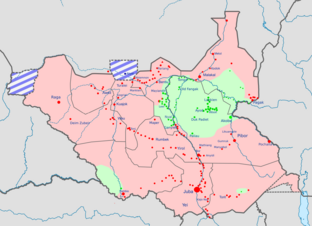South Sudanese Civil War facts for kids
Quick facts for kids South Sudanese Civil War |
||||||||
|---|---|---|---|---|---|---|---|---|
 Military situation in South Sudan on 22 March 2020
Under control of the Government of South Sudan Under control of the Sudan People's Liberation Movement-in-Opposition Under control of the Government of Sudan (For a more detailed map of the current military situation, see here.) |
||||||||
|
||||||||
| Participants | ||||||||
Allied militias: State allies: |
TFNF |
|||||||
| Commanders and leaders | ||||||||
(President of South Sudan) |
(Leader of the SPLM-IO) Yoanis Okiech † Paul Malong Awan (from 2018) |
|||||||
| Strength | ||||||||
| SPLA: 150,000 (2015) Uganda: 5,000+ (2014) |
12,523 (2015) 15,000 soldiers (2019) 1,800 police (2019) |
SPLM-IO: At least 10,000 defectors Nuer White Army: 25,000 (2013) NAS: 20,000+ (NAS claim, 2017) SSPA: 15,000 (SSPA claim, 2017) |
||||||
| Casualties and losses | ||||||||
| 10,659 killed, 9,921 wounded (Jan. – Oct. 2014) |
5 peacekeepers killed (by Aug. 2015) | Unknown | ||||||
| 190,000 violent deaths (Apr. 2018) 193,000 non-violent war-related deaths (Apr. 2018) 383,000 total deaths (Apr. 2018) |
||||||||
| 1.5 million+ civilians had fled South Sudan and 2.1 million+ civilians internally displaced (as of 2017) Four Kenyan civilians killed. |
||||||||
The South Sudanese Civil War was a big fight in South Sudan. It happened between the country's government and groups who were against it. In December 2013, the President, Salva Kiir, said his former helper, Riek Machar, and ten other people tried to take over the government. Machar said this was not true. He then left to lead a group called the Sudan People's Liberation Movement-in-Opposition (SPLM-IO).
Fighting started between the government's army, the Sudan People's Liberation Movement (SPLM), and Machar's SPLM-IO. This started the civil war. Soldiers from Uganda came to help the South Sudanese government. The United Nations also sent peacekeepers to the country. They are part of the United Nations Mission in South Sudan (UNMISS).
In January 2014, the two sides agreed to stop fighting for a short time. But the fighting kept going. More agreements were made, but they did not last. Many groups tried to help them make peace. These included the African Union and the United Nations. Other countries like China, the EU, the USA, the UK, and Norway also helped.
A peace deal was signed in August 2015. It was called the "Compromise Peace Agreement." Machar came back to the capital city, Juba, in 2016. He was made vice president. But then, fighting started again in Juba. The SPLM-IO group left and went to other areas. President Kiir then chose a different person, Taban Deng Gai, to be vice president instead of Machar. This caused more problems among the groups fighting the government.
Another agreement to share power was made in August 2018. Finally, on February 22, 2020, President Kiir and Machar made a deal. They formed a new government together.
Contents
Impact of the War
By April 2018, it was thought that about 400,000 people had died in the war. About 10% of these were children. Many people were forced to leave their homes. Over 4 million people were displaced. About 1.8 million of them moved to other places inside South Sudan. Around 2.5 million people fled to nearby countries like Uganda and Sudan.
The war also caused a lot of hunger. Fighting in farming areas meant that 6 million people faced starvation. Some areas even had a famine in 2017. The country's money system was also badly hurt. By 2017, people's income had dropped by half. Prices for goods were also rising very fast.
Groups Involved in the Conflict
Government Supporters
 Sudan People's Liberation Army (SPLA): This was the main army of the South Sudanese government.
Sudan People's Liberation Army (SPLA): This was the main army of the South Sudanese government. South Sudan Liberation Movement (SSLM): This group joined the government side. They helped fight against other groups.
South Sudan Liberation Movement (SSLM): This group joined the government side. They helped fight against other groups.
Rebel Groups
 SPLM-IO: This was the main group fighting the government. It was led by Riek Machar.
SPLM-IO: This was the main group fighting the government. It was led by Riek Machar. Nuer White Army: This group was made up of Nuer people. They originally protected cattle. They joined Riek Machar's side in the war.
Nuer White Army: This group was made up of Nuer people. They originally protected cattle. They joined Riek Machar's side in the war. SSDM: This was a larger group for different rebel forces. One part, the SSDM-Cobra faction, fought the government. Another part, the Agwelek forces, also fought the government.
SSDM: This was a larger group for different rebel forces. One part, the SSDM-Cobra faction, fought the government. Another part, the Agwelek forces, also fought the government. National Salvation Front (NAS)
National Salvation Front (NAS) South Sudan United Front (SSUF)
South Sudan United Front (SSUF)
Outside Help
 UNMISS: The UN sent peacekeepers to protect civilians. They also helped deliver aid.
UNMISS: The UN sent peacekeepers to protect civilians. They also helped deliver aid. Uganda: Uganda sent its soldiers to help the South Sudanese government. They helped the government take back cities from the rebels. Uganda later agreed to take its troops out of South Sudan.
Uganda: Uganda sent its soldiers to help the South Sudanese government. They helped the government take back cities from the rebels. Uganda later agreed to take its troops out of South Sudan.
See also
 In Spanish: Guerra civil de Sudán del Sur para niños
In Spanish: Guerra civil de Sudán del Sur para niños
- Baratuku refugee settlement
- Central African Republic conflict (2012–2014)

